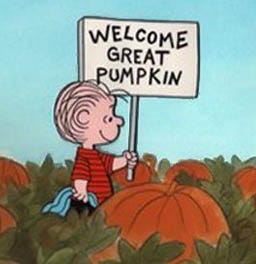|
 |
The Editor’s Corner: The Uncommon Common Experience
The decline of broadly-shared viewing experiences is indicative of our growing disengagement from each other
I hope you and your family had a fun, spooky and treat-filled Halloween last week. I’d be lying if I said mine wasn’t missing something important: Snoopy.
In the last couple of years, the 1966 Halloween special “It’s the Great Pumpkin, Charlie Brown” has been gone from publicly available free television and only accessible on paid subscription-required AppleTV+. After decades of airing on ABC and NBC, Americans could no longer turn on their TV on the appointed night and join scores of others to thrill to their favorite beagle as a World War I flying ace or laugh as Charlie Brown collects a trick-or-treat bagful of rocks.
OK, I get it: In the grand scheme of things, this is not a big deal. But the fate of “Great Pumpkin” is indicative of something bigger happening in our society: Common experiences are becoming increasingly uncommon. And when we share less, even on television, we’re on the path to further disengagement from one another.
Of course, the shared viewing experience was much easier to achieve in the past. When ABC, NBC and CBS were the only game in town, there was significant crossover in Americans’ TV-watching experiences. One could gather around the water cooler and rest assured that many colleagues or friends probably watched the same programs the previous evening. Hence, there was always something to talk about. Entertainment connected people.
Fun fact (and by “fun,” I mean “depressing”): The most-watched scripted prime-time TV program in history, the final episode of M*A*S*H, aired 40 years ago this year. And, even though the country’s population has grown by 100 million since then, those viewership numbers are still staggering to modern eyes: The finale captured more than 121 million total viewers, and more than half of all televisions across the country at the time were tuned in.
Nowadays these kinds of numbers are all but impossible to replicate—at least for entertainment programs (there are a handful of sports events each year—led by the Super Bowl—that can still pull tens of millions of viewers). It’s not hard to understand why: The way in which we get entertainment has become extremely atomized. The Big Three TV networks gave way to dozens, then hundreds of networks—channels tailored to more-defined interests, everything from news to cooking to sci-fi to kids’ programming. Later, the emergence of DVR, then streaming services like Netflix and Hulu, revolutionized the timing of our TV consumption: Instead of building our schedules around a specific program—at the same time others would also be viewing it—we could view that program at the time of our choosing. Not surprisingly, cable viewership has subsequently fallen off a cliff, particularly among young people—after all, now we can have an even more convenient, more custom experience. Flipping channels and landing on a show or a movie is a relic of the past: Now, one can choose to watch exactly what they want instead of what the networks dictate.
In short, today more than ever, entertainment is tailored to the individual: Each of us can watch, read or listen to what we want, when we want, where we want. At first glance, this seems great—the victory of individual preferences and all—but there is also a dark side. When we retreat inside our own particular interests, inside our own cultural bubbles, we weaken our connections to others who have different tastes and likely different life experiences and outlooks—perhaps to the point where we can’t even relate to one another.
An obvious example is cable news. As Martin Gurri observed a year ago in Discourse, the cable-news-watching audience self-sorts by ideology—Republicans turn on Fox News, Democrats run to MSNBC. We watch the news to validate our own thoughts and feelings. And because there are news options that fit and affirm these thoughts and feelings, we never have to encounter or engage with the ones we don’t agree with. Not surprisingly, our ability to find common ground with others—or even acknowledge they might have a valid point—atrophies. Pew Research Center polls reveal more than 7 in 10 Republicans believe Democrats are more immoral than other Americans, while more than 6 in 10 Democrats say the same of Republicans
Entertainment programming is becoming increasingly fractured as well—and there is a similar deleterious effect. Several years ago the New York Times observed that the viewership of our most popular television programs frequently exhibits a clear urban-rural divide. Of course, the geographical divide is closely related to America’s political divide, with Democrats tending to cluster in cities and their surroundings and Republicans more likely to inhabit rural and exurban areas. When Republicans are watching “Duck Dynasty” and Democrats are watching “Modern Family,” with a decline in crossing over, we’re losing yet another thing we used to have in common. Again, it becomes more difficult to understand people on “the other side” when we know less of how they live their lives and what they watch in their free time.
It seems the more we lament this social atomization, the more our society facilitates it. Take voting by mail: Being able to cast a ballot by mail is convenient and increases people’s access to the polls. Today, a majority of states plus the District of Columbia don’t require a reason to vote absentee. But there is a drawback: Voting is no longer a civic event that we engage in together on an appointed day. Our society has decided—rightly or wrongly—that the upsides outweigh that downside. Yet another shared activity thus falls by the wayside.
In a fascinating article for Discourse this past week, Michael Strambler wrote that when we believe there’s little shared ground between us, “the negative implications of adopting such an outlook are severe for the relationships that hold society together.” While Strambler was writing about the erroneous belief that white and Black people are too fundamentally different to understand one another, I think his point is relevant here, too.
But all is not lost. While we now have countless entertainment options and may never be able to recreate the same shared experiences from decades past, there are still plenty of ways to seek commonalities—starting in our own neighborhoods. Does anyone want to get together later this month for “A Charlie Brown Thanksgiving” watching party?
Meanwhile…
What I’m Listening To: My favorite band, the Mavericks, performs a set of shows in Tarrytown, New York—just outside of Sleepy Hollow—each year on Halloween weekend, and this year, I had the chance to check one out. As their name suggests, they defy categorization. While the band is rooted in country music, their songs run the gamut from Latin to ’50s pop to straight-ahead country to Tejano and back again—all performed with an infectious joy, intensity and abandon that is hard not to love (and dance to).
While the band marked their 30th year a couple of years back, they’re still as fresh and exciting as ever. Their live shows are a rollicking good time, complete with a backing accordion and horn section. Plus—and this is the hill I’ll die on—frontman Raul Malo’s voice is the best there is, with a range that rivals Roy Orbison. For a good introduction to the Mavericks’ music, check out “All You Ever Do Is Bring Me Down,” “I Should Have Been True,” “Back in Your Arms Again,” “Dream River” and “Ride with Me.”
What I’m Baking: Maybe it’s the arrival of fall, maybe it’s the return of “The Great British Baking Show,” but lately, I’ve been turning my attention to baking. I find baking a good deal more challenging than cooking; that’s because while cooking may be an art, baking is a science. Also, there’s something about chillier temperatures that leaves me wanting sweet treats.
This week’s oven concoction was pumpkin whoopie pies (you can find the recipe here). The soft spice-laden cake outside—flavored with pumpkin puree, cinnamon, cloves and ginger—is a perfect foil to the sweet cream cheese frosting inside. Now to start thinking about Thanksgiving recipes…how is it November already?
Next time around, you’ll be hearing from our wonderful managing editor, Christina Behe. Meanwhile, have a wonderful week!
You’re currently a free subscriber to Discourse .

